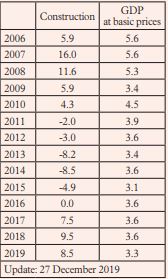Publicité
Construction: a key driver of economic growth?
Par
Partager cet article
Construction: a key driver of economic growth?

Construction activity being a particular type of investment, a project has both positive and negative macroeconomic effects, explains the author. As the economy approaches maturity, construction growth rate slows down, and thus its share (as a percentage of GDP) declines.
Contrary to tourism, manufacturing and financial services, construction is a non-tradable sector, which includes housing construction, construction of business structure and infrastructure-related construction. There is a relationship between stages of economic growth and demand for construction. Construction demand is low in less developed economies. During their expansion phase, the growth in construction outstrips the rest of the economy and therefore rises as a share of gross domestic product (GDP). As the economy approaches maturity, the growth rate of construction slows down, and as a result the construction share (as a percentage of GDP) declines. Mauritius appears to be the case: the contribution of construction to GDP was 4.9 per cent in 2019, down from 7.0 per cent in 2010, in spite of all the big infrastructure projects.
In 2019, the construction sector posted a real growth of 8.5 per cent “based on implementation of main public projects (Metro Express, Côte d’Or MultiSports Complex and Road Decongestion Programme) and private projects (Property Development Scheme, Smart City projects and shopping malls)”, to quote the National Accounts. However, the overall economy grew by only 3.3 per cent. Is this a paradox? Not really so.
The construction industry imports a lot of goods (materials and equipment) and se vices (foreign labour), bearing in mind that trade deficit drags down economic growth. While investments in infrastructure (transport, public services) can stimulate economic growth and national productivity in the long run, they are not necessarily a key driver of economic growth.

Substitution effects
The contribution of the Metro Express project to GDP is low because of the nearly 100 per cent import content. Trains, rails and all other construction materials and accessories are not manufactured in Mauritius, but imported wholesale. Nearly 100 per cent of Metro-related government expenditure is outlays on imported items. The bulk of wages connected to the project is paid to foreign workers. As Metro-related imports go up, trade deficit widens.
Substitution effects have to be taken into account. First, whilst new jobs will be created by Metro Express, existing jobs in the bus industry will be destroyed, hence little net job creation. Second, while the Metro stations will evolve into new shopping areas, shopping transactions will shift from one place to the Metro stations, which will not translate into additional business incomes. Third, traffic congestion will be displaced, or at best marginally improved. Fourth, air pollution may decrease, but people will be subject to noise and visual pollution.
In the same vein, higher levels of consumption expenditure do not lead to greater economic growth. Boosting consumption in the economy (by way of subsidies, minimum salary, negative income tax, increases in old-age pension) does not necessarily rev up production and employment, but rather imports of goods and services. The Mauritian economy relies on foreign trade and is thus prone to huge current account deficits (imports less exports of goods and services). The latter are currently financed by income stemming from the global business sector, by foreign direct investment and by export proceeds. Otherwise, a deficit position of the capital account has to be plugged with a drawdown on the foreign exchange reserves of the country or with external borrowing.
Macroeconomic effects
A construction project has both positive and negative macroeconomic effects. On the one hand, there exists the multiplier effect: money spent, which went initially to a construction firm, increases the demand of goods and services for other firms, which will employ more people or will raise the salaries, thus leading to more consumption spending. There is also the investment accelerator effect due to more purchase of in- vestment goods by enterprises in the face of increasing demand.
On the other hand, the private sector will be affected by the crowding-out effect: aggregate demand will fall as a result of a reduction in (investment or consumption) expenses due to a rise in interest rate following an increase in public spending that causes inflation. The multiplier effect on the economy is all the more mitigated by the leakage effect as income is spent on imported products. Last but not least, demand of money increases: those receiving more money (higher salaries or dividends) choose to hold a greater proportion of their wealth as cash instead of buying products or assets.
Construction, modernisation and maintenance of public infrastructure are very costly. Development of infrastructure should not lead to excessive public debt which has a negative impact on economic growth. Public sector debt rose to 65.3 per cent of GDP in June 2019 when the international norm is 60 per cent. To bring it back to that level, the International Monetary Fund has urged the Ministry of Finance to undertake fiscal consolidation, i.e. to increase revenue and reduce spending.
Factors driving investment
Construction activity is a particular type of investment. Overall, investment is typically driven by factors such as general economic conditions, stock market performance and credit conditions (firms generally face liquidity constraint). Reliable indicators for firm level investment are the interest rate, the Tobin’s q ratio (market valuation of capital assets to their replacement cost) and firm fundamentals such as profit or dividend.
Particularly, investment in residential structure is highly volatile and pro-cyclical. Housing construction is driven by demographic trends (Mauritius had a population growth of 0.03 per cent in 2018), house- hold income (the average household disposable income in 2017 stood at Rs 36,803 per month while it was Rs 90,019 for the 20 per cent of households at the upper end of income range, according to Statistics Mauritius), housing prices or rent, and credit conditions.
The performance of the construction sector directly affects the asset quality of Mauritian banks in view of its relevance and importance in their loan portfolios. As the construction industry picked up in 2017, the Non Performing Loans ratio in this sector declined from 9.2 per cent as at end-December 2016 to 7.9 per cent as at end-December 2017, but deteriorated again to 11.4 per cent as at end-December 2018, and improved slightly to 10.6 per cent as at end-June 2019, according to the Bank of Mauritius.
Finally, geography also affects the cost of construction. Countries with high population densities (654 persons per km2 for Island of Mauritius) would require more high-rise buildings, whose construction costs are steeper than low-rise buildings. Countries endowed with popular tourism destinations necessitate more tourism infrastructure to accommodate tourism demand and therefore higher construction needs. It remains that development of infrastructure must go hand in hand with strong economic reforms to improve the business climate.

Publicité
Publicité
Les plus récents






